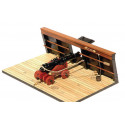


To ride, fly, sail, everything is there at MHD!






Easy construction suitable for beginners, completion time of 5 to 10 hours.

Gun for Smoothbore boats on deck 1:24
Plus de detailsGun for Smoothbore boats on deck 1:24
Gun for Smoothbore boats on deck 1:24.
Kit features:
Dimensions :
The 18th-century naval smoothbore deck cannon was a weapon with a flat trajectory, having a point-blank range of 300 yards. It could use various types of projectiles typical of that era: solid shot, hot shot, bombs, grape, and canister.
In addition to standard ammunition, the gun crews would occasionally employ whatever scrap materials were available, such as bolts, chains, nails, and even fragments of kettles.
The cannon was mounted on a wooden carriage made of elm, chosen for its resistance to splintering when hit by enemy fire and its ability to absorb the recoil shock of the firing gun. Different tackles were used by the gun crew to adjust the position of the weapon.
Given the unpredictable motion of both the target and the gun caused by the sea, achieving accurate gunnery at a distance required a skilled gunner, a well-drilled gun crew, and a bit of luck.
Consequently, when evenly matched ships encountered each other, they often sailed alongside and exchanged broadsides until the more damaged vessel lowered its flag in surrender.






